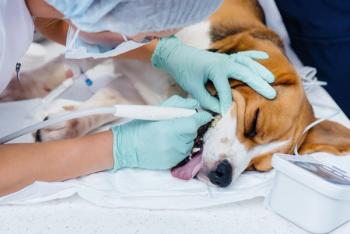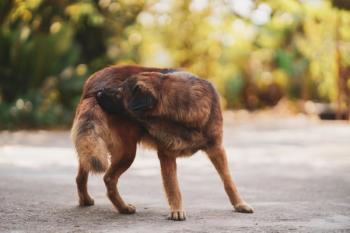
Poisonous plants and plant-related intoxication (Proceedings)
While most small animals being seen by veterinarians are not herbivorous, they will from time to time ingest plants out of boredom or maybe for other reasons.
While most small animals being seen by veterinarians are not herbivorous, they will from time to time ingest plants out of boredom or maybe for other reasons. For this reason, the clinician must be aware of some of the more common toxic plants which their patients may ingest. This presentation is meant to discuss some of the more common plants. Plant identification can be quite difficult because of the tendency of using the same common name for different plant species. Dr. Tony Knight, Colorado State University has published “A Guide to Poisonous House and Garden Plants,” Teton NewMedia, 2006, which describes the plant, including good photographs, and the toxic condition produced.
Sago Palm
The sago palms include: Cycas circinalis (fern palm) Cycas circinalis (fern palm), Cycas revoluta, Zamia integrifolis (coontie,Florida arrowroots), Microcycas spp. , Macrozamia miquelii, Macrozamia spiralis (Macrozamin, from Australia), Encephalartos barkeri (Macrozamin, from Africa) Encephalartos barkeri (Macrozamin, from Africa), and Dioon edule (chamal).
All parts the plants are poisonous, but the seeds or “nuts” contain the largest amount of toxin. Cycasin is the toxin contained in the various Cycad species. Cycasin is a carcinogenic glycoside. The seeds are the most toxic and contain 0.2-0.3 % cycasin. From the seeds and roots of cycads cycasin can be extracted as well as its metabolite methylazoxymethanol, a highly toxic moiety related to the nitrosamine. The ingestion of just one or two seeds can result in very serious effects, which include vomiting, diarrhea, depression, seizures and liver failure. Post mortem lesions include: hepatic hemorrhage, hepatic centrolobular necrosis is especially evident microscopically, hemorrhagic enterititis, and edema of the gallbladder wall.
There is no good treatment, but should GI decontamination and normal emergency care procedures which may include blood transfusions. Additional treatment is directed towards providing an adequate caloric intake with a high quality protein diet supplemented with fluids including dextrose and vitamins K1 and B12. Methyl donors such as choline or methionine are indicated. S-adenosyl methionine and milk thistle (Silybum marianum containing silymarin and silibinin) have been suggested as additional treatments of aflatoxin-induced hepatotoxicity.
Lilies
Members of the Lilium spp. are considered to be highly toxic to cats. These include: Lilium longiflorum (Easter Lily Easter Lily), Lilium lancifolium Lilium lancifolium ( Tiger Lily ) and Homerocallis spp. Hemerocallis spp. ( Day Lily Day Lily) .
While the poisonous component has not yet been identified, it is clear that with even ingestions of very small amounts of the plant, severe kidney damage could result. There is little evidence to indicate definitely whether or not other domestic species are sensitive. Toxicosis in cats has been reported after consumption of leaves or flowers of these plants. The disease syndrome is characterized, acutely, as a gastrointestinal upset, reduced activity and anorexia, followed by renal failure developing 48-96 hours after ingestion.
The syndrome is associated with a high mortality if the animal is not treated vigorously. The most profound post mortem lesion is renal tubular necrosis with preservation of the basement membrane. Aggressive treatment must begin within 24 hours of ingestion for best results (i.e., before renal failure occurs.) This should include: induction of emesis if indicated, administration of activated charcoal follow with a saline cathartic and fluid diuresis (2-3 times maintenance for at least 24 hours.) Peritoneal dialysis may be of value as the basement membrane remains intact.
Azalea/Rhododendron
Members of the Rhododenron spp. contain substances known as grayantoxins, which can produce vomiting, drooling, diarrhea, weakness and depression of the central nervous system in animals. Severe azalea poisoning could ultimately lead to coma and death from cardiovascular collapse.
Oleander
All parts of oleander (Nerium oleander )are considered to be toxic, as they contain cardiac glycosides that have the potential to cause serious effects-including gastrointestinal tract irritation, abnormal heart function, hypothermia and even death. Cardiac glycosides, similar to digitalis, affect many organs because of the action on cellular metabolism. Green plant material is bitter and animals do not normally ingest it.
However, the dried plant material is often ingested by herbivorous animals probably because of the increased palatability due to the release of sugars from the injured plant cells. All animals, including man are susceptible. The horse is especially susceptible. Twenty leaves will cause intoxications in the horse, and 1-2 leaves can induce intoxications in a child. Clinical signs include vomiting, diarrhea, trembling, cardiac stimulation (initially), vasoconstriction, mydriasis, cold extremities, paralysis, cardiac depression, coma, and death. Post mortem lesions include gastroenteritis and widespread petechiation.
Diagnostic procedures should include performing electrocardiography. Early in the disease there may be a profound bradycardia which should be treated with atropine at a dosage rate of 0.02-0.04 mg/kg. Later in the intoxication, even after the administration of atropine, tachycardia with many premature ventricular contractions may occur. If the animal is seen at this time, atropine would be contraindicated. Beta adrenergic blockers such propranolol (0.5 - 2.0 mg/kg, IV followed by CRI 0.02-0.06 mg/kg/min as needed.) Ventricular tachycardia should be treated using lidocaine or procainamide at normally recommended dosages. Digoxin-specific Fab fragments may be of value. Once the animal is stabilized, normal GI decontamination procedures should be instituted.
Kalanchoe
This plant contains bufadienolidesBufadienolides (similar to cardenolides)which are cardio-active glycosides and similar to the toxic agent(s) found in Bufo toads which can also induce a neurological syndrome. The initial presenting clinical signs may gastrointestinal irritation resulting in vomiting and diarrhea as well as convulsions. After controlling the neurological signs with diazepam (5-10 mg/kg IV or P.O.), the treatment should proceed as with the treatment of animals which have ingested oleander.
Castor Bean
The poisonous principle in castor bean (Ricinus communis) is ricin, a highly toxic protein that can produce severe abdominal pain, drooling, vomiting, diarrhea, excessive thirst, weakness and loss of appetite. Severe cases of poisoning can result in dehydration, muscle twitching, tremors, seizures, coma and death..It is interesting to note that in 98 dog cases reported over a 11 year period, 76% developed clinical signs but only 7 died or 7.1% of total cases or 9% of those developing signs (3 were euthanized for a true case fatality rate of 5%.) (8).
Oral exposure to castor beans have been reported in dogs and humans(6-8). It should be noted that the beans must be broken or masticated for the ricin to be released(7,8). Even with the oral exposure to pure ricin or castor beans, there may be a latent period of 8 to 24 hours. The gastrointestinal signs(6-8) which may develop include: vomiting w/wo blood, depression, diarrhea w/wo blood, abdominal pain, and anorexia. Lesions due to ingested ricin or castor beans include:(3,9) liver necrosis, spleen necrosis, kidney necrosis, along with hemorrhagic gastroenteritis. There are no post-ingestion antidotes for ricin. Normal therapy for oral exposures should include: induction of emesis, if indicated, administration of activated charcoal (1-5 gm/kg in a slurry), a cathartic (magnesium sulfate[250 mg/kg,PO] or sorbital [70%, 3 ml/kg, PO]) unless the animal already has diarrhea, and the placement of at least one indwelling catheter for fluid therapy and other supportive medications.
The hypotension which normally develops should be treated vigorously as in any emergency situation. Any seizures should be treated with diazepam (0.5-1.0 mg/kg, IV). Sucralfate (0.25 to 2 gm, PO, TID) should be used as needed.. The affected animals should be fed a soft, bland diet.The differential diagnoses could be many, depending upon the locale. Those which should be included include: garbage poisoning, any other intoxications, dietary causes and other gastrointestinal inflammation from numerous etiologies.
Yew
The yews, Taxus baccata (English Yew), Taxus cuspidata (Japanese Yew), Taxus canadensis (American Yew), and Taxus brevifolia (Western Yew), contain a toxic component known as taxine, the alkaloid is a cardio depressant, causing bradycardia and then stopping the heart in diastole. The entire plant is toxic and dried plant material may retain the alkaloid for several months making the twigs hazardous to animal chewing and/or ingesting them. The plant is so toxic that a dog could ingest a potentially lethal dose, just by playing with the branches. Large doses may result in sudden death without additional symptoms and often the animal is found close to the offending plant and frequently have twigs or leaves still in the mouth.
Presence of plant material in the GI is sufficient evidence of cause of death in such cases. Other significant lesions are absent. Less severely poisoned animals may display other signs before succumbing. The onset of clinical signs is sudden and the course short. These clinical signs may include evidence of: nausea, vomiting, diarrhea, abdominal pain, trembling, increased aggressiveness, dyspnea, evidence of confusion, convulsions, circulatory failure, collapse, coma and death. There is no specific treatment, but normal decontamination procedures should be instituted.
Brunfelsia spp. (Yesterday-Today-and-Tomorrow)
This plant is native to South and Central America and the West Indies, grows wild in the Florida Keys and Southern Florida. All species are ornamentals in North America and will be found in gardens in the southern regions or as tub plants elsewhere. The toxic principles are brunfelsamidine and hopeanine. These chemicals have a long half-life in dogs based on the duration of clinical signs. Dogs are primarily affected although cattle have been affected. Probably all animals which ingested the plant would become intoxicated. The clinical signs in affected animals include: excessive salivation with intermittent coughing and gagging. and strychnine-like clonic-tonic convulsions .
Affected animals have also exhibited either diarrhea or constipation. Treatment of intoxicated animals is directed towards controlling the convulsions with pentobarbital. Affected animals may require 3-4 days of sedation. As with strychnine the stomach must be emptied by gastric lavage followed by activated charcoal and a saline cathartic. Because of the prolonged duration of convulsions, the affected animal should be placed in intensive care. Lesions seen in affected animals were found in the intestinal tract with edema and hyperemia of the terminal ileum.
Avocados
A variety of species including cattle, horses, goats, rabbits, canaries, budgerigars, cockatiels, ostriches, and fish have been poisoned by eating the leaves and fruits of the avocado tree. The leaves, bark, seeds, and skin of the fruit are toxic. The leaves remain toxic when dried. Both the Guatemalan and the Mexican varieties of avocado are toxic to animals and birds, with most poisoning being associated with the consumption of the Guatemalan and Nabal varieties of avocado. There is some variability in toxicity between different varieties of avocado, the Mexican variety being considered the least toxic. However, hybrid varieties of avocados are toxic to birds. Persin, a compound isolated from the leaves is believed to be the toxic agent..
Clinical Signs
Acute pulmonary edema as a result of cardiomyopathy and heart failure, have also been reported in rabbits and goats that have died from avocado poisoning. The cardiomyopathy is manifested as an acute noninfectious degeneration and necrosis of myocardial tissue, which, if severe, will result in acute death of the animal. Ostriches eating the leaves and immature fruits of the Guatemalan variety of avocado have developed fatal cardiomyopathy and congestive heart failure with 96 hours of eating the plants . In other birds, avocado poisoning is characterized by respiratory distress and sudden death. Deaths usually occur 1 to 2 days after consumption of the avocado.
Cattle, horses, goats, and rabbits develop noninfectious mastitis after eating avocado leaves . If no further avocado leaves were fed, the udder edema regressed and milk production returned, but not to the levels before feeding the avocado leaves. Generalized necrosis of the mammary gland epithelium with no significant cellular inflammatory response and sloughing of necrotic cells are characteristic microscopic findings. At postmortem examination, generalized congestion of the lungs, hydropericardium, and subcutaneous edema in the pectoral area are typical. Similar noninflammatory necrosis of the myocardium and lactating mammary gland were observed in goats and mice fed avocado leaves.
Horses and other livestock should not be allowed into avocado orchards and the trees should not be planted adjacent to livestock enclosures. The fruits and seeds should not be fed to pet birds. Until more is known about avocado intoxication, the plant should not be fed to herbivorous captive reptiles.
Newsletter
From exam room tips to practice management insights, get trusted veterinary news delivered straight to your inbox—subscribe to dvm360.




